This was published 7 months ago
‘Gotta be fun, gotta be cool, gotta be sexy’: The candidates vying to be Japan’s PM
The victor will inherit a surfeit of challenges, starting with a sputtering economy fighting to maintain modest growth in the face of a rapidly shrinking and ageing population.
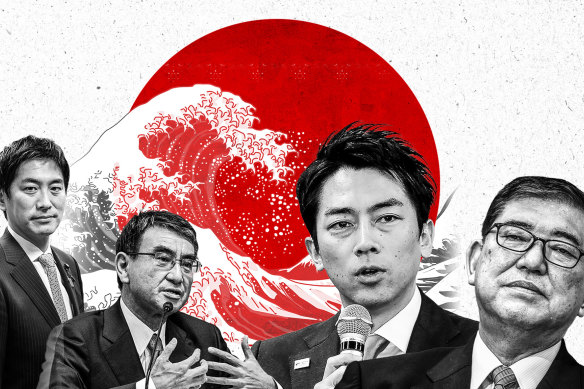
The race to become the next Japanese prime minister.Credit: Monique Westerman
At just 43, Shinjirō Koizumi is a rising star of Japanese politics and one with a penchant for capturing headlines and ruffling the feathers of the country’s conservative ruling party.
He married a TV presenter and then caused a stir in Japan’s patriarchal society by becoming the first serving government minister to take parental leave. He has also expressed support for legal reform to allow women to keep their surnames after marriage, putting him at odds with staunch conservative colleagues in the Liberal Democratic Party (LDP).
This year he surfed the waters near Fukushima to show they were safe from radiation following the 2011 tsunami and nuclear plant meltdown, and during his stint as environment minister he said tackling issues like climate change has “gotta be fun, gotta be cool, gotta be sexy, too”.
As a fourth generation politician and son of a popular former prime minister, his political pedigree in the LDP has given him an outsized profile and had him widely touted as a leader-in-waiting.
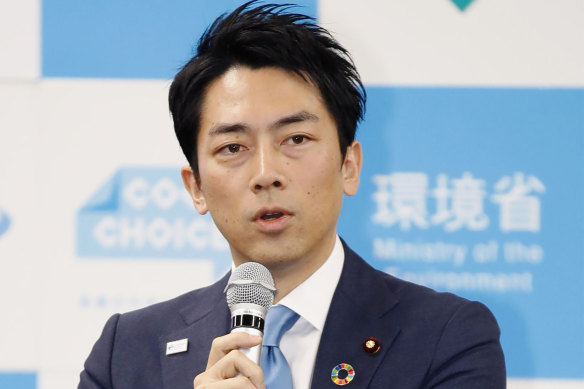
Former environment minister Shinjiro Koizumi, 43, is considered a rising star in Japan’s Liberal Democratic Party.Credit: AP
Now, with an unpredictable race under way for the presidency of the LDP, and by extension the prime ministership, Koizumi may be about to cash in on all the expectation. He is poised to make a bid for the top job, positioning himself as the reformist fresh face of an old political machine, despite being a firm establishment figure.
Prime Minister Fumio Kishida fired the starting gun on the leadership contest when he announced on August 14 that he would not recontest his presidency of the LDP after a three-year stint.
For a nation whose democracy has been dominated by the LDP for decades, there is no single favourite to replace Kishida. When the party elects a new leader on September 27, the winner will also take over as prime minister and may call a snap national election to capitalise on momentum and media coverage.
The victor will inherit a surfeit of challenges, starting with a sputtering economy fighting to maintain modest growth in the face of a rapidly shrinking and ageing population. Then there’s the intensifying security challenge posed by a rising China, brought into sharp relief this week when a Chinese spy plane breached Japan’s airspace for the first time.
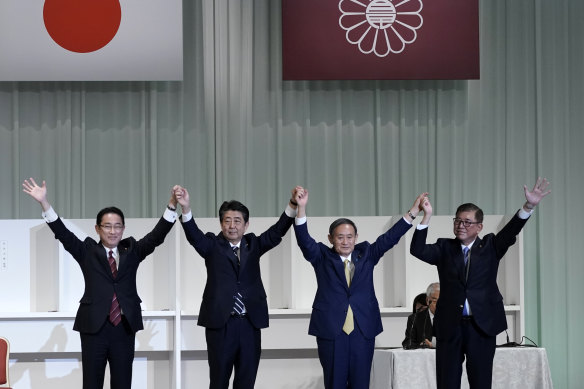
In 2020 (from left), Fumio Kishida, Shinzo Abe, Yoshihide Suga and Shigeru Ishiba celebrated Suga’s election as new head of the Liberal Democratic Party.Credit: AP
For a party heavy with political dynasties, and dominated by men aged in their 50s and 60s who have spent careers climbing the internal hierarchy, the question is whether Japan can produce the leadership it needs to meet these challenges.
Whether Koizumi or one of his older colleagues prevails, they will confront a crisis of trust among dispirited Japanese voters, with Kishida having bowed out with a cabinet’s approval rating that plunged to a diabolical 15.5 per cent in recent months.
He hands over a legacy of public backlash to his handling of a slush fund scandal that embroiled the LDP, and revelations of the party’s ties to the controversial Unification Church that emerged after the assassination of former prime minister Shinzo Abe in 2022.
“Now that the LDP’s approval rate is very low and the next lower house election is looming, I think all the candidates will express that they will change the LDP. However, it remains to be seen how much they can and are willing to change,” said Sota Kato from the Tokyo Foundation for Policy Research.
Who is running?
So far, three LDP lawmakers have formally declared they will contest the party leadership: former defence minister Shigeru Ishiba, Digital Minister Kono Taro and former economic security minister Takayuki Kobayashi. Koizumi has indicated he will announce his run on September 6.
As many as 11 candidates, including Foreign Minister Yoko Kamikawa, who will vie to become Japan’s first female leader, are said to be keen to enter the race for the top job, though not all expected to secure the endorsement of 20 LDP parliamentarians, a requirement to run. Other possible contenders include LDP secretary-general Toshimitsu Motegi, and chief cabinet secretary Yoshimasa Hayashi.
Because the position of LDP president is an internal party one, the public don’t participate in the voting process. Instead, the vote is held among rank and file party members and LDP lawmakers.
Analysts say the unusually crowded field of candidates is making it difficult to pick a clear front-runner, and some aspirants are competing for the same bloc of conservative or moderate votes within the party. One factor adding to the uncertainty is that the candidates who are most popular among the LDP base or the broader Japanese public, often are not popular with their peers in parliament.
This is the case with Ishiba, the former defence minister, who regularly tops opinion polls as the public’s preferred prime ministerial candidate and who at 67 is making his fifth attempt to win the party presidency.
“There is a reason why he never made it to the top, in spite of the fact that he’s been around for a very long time,” said Koichi Nakano, a professor of Japanese politics at Tokyo’s Sophia University.
“He’s not liked by his parliamentary colleagues. He’s much more of a loner, and he’s particularly shunned by the party bosses, even though he’s relatively popular among the electorate.”
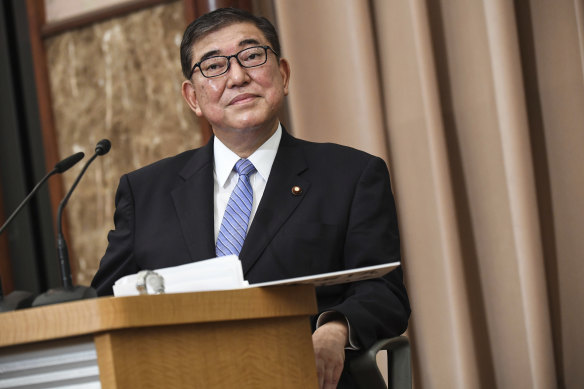
Former defence minister Shigeru Ishiba regularly tops opinion polls among the Japanese public.Credit: AP
Kono, 61, also has a relatively high profile, and came runner-up to Kishida in 2021. But as digital minister he has copped public pushback for his efforts modernise Japan’s bureaucracy, including the bungled rollout of the country’s digital ID system. He speaks fluent English, regularly communicates directly with his 2.5 million social media followers on X, and has supported progressive causes such as legalising same-sex marriage.
These things have given him a reputation as a tech-savvy, reform-minded political maverick at odds with the conservative ranks of the LDP.
Announcing his candidacy this week, he emphasised his experience as the former foreign affairs minister, saying “I can help steer the world” as he pushed for Japan to play a greater leadership role in global affairs.
“Kono is in a situation where the right wing really hates him, he has alienated parts of the party, and his support among the public has also fallen off over the last several years,” said Tobias Harris, who runs Japan Foresight, a political risk advisory firm in Washington.
The young guard
Aged in their 40s, Koizumi and Kobayashi are the youngest candidates in the race and can leverage their relative youth to signal a changing of the guard within the LDP.
Koizumi, a graduate of Columbia University in New York and son of former prime minister Junichiro Koizumi, has long been heralded as a future leader, is popular with younger LDP members and has edged out Ishiba as the favoured candidate in some recent polls.
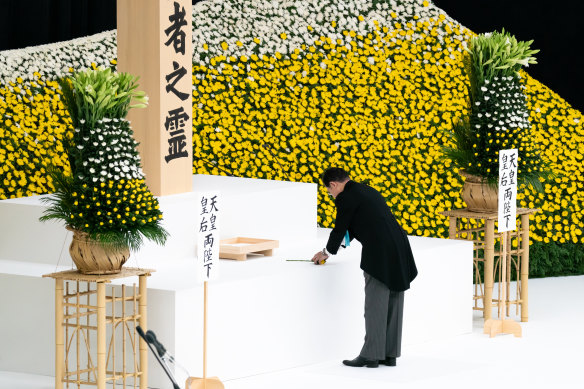
Bowing out: Japanese Prime Minister Fumio Kishida on August 15 at a service to mark the end of World War II.Credit: Getty Images
Though he took over his father’s parliamentary seat in 2009, Koizumi has not held a top cabinet post, with his ministerial experience limited to the environmental portfolio he held for two years until 2021.
“The liability for him is that he is only 43 and there are older people in the party who might resent his jumping ahead,” Harris said.
Kobayashi, on the other hand, is from the party’s more conservative ranks and is considered a long shot this time around.
A female prime minister?
The possible entrance into the race of Kamikawa, the 71-year-old foreign minister, and Sanae Takaichi, 63, the economic security minister who was a close ally of the late former prime minister Abe, has generated hype about the prospect of a watershed first female prime ministership. But both women appear to be an outside chance of claiming the top job, and some experts put the party’s conservative leanings as a key hurdle.
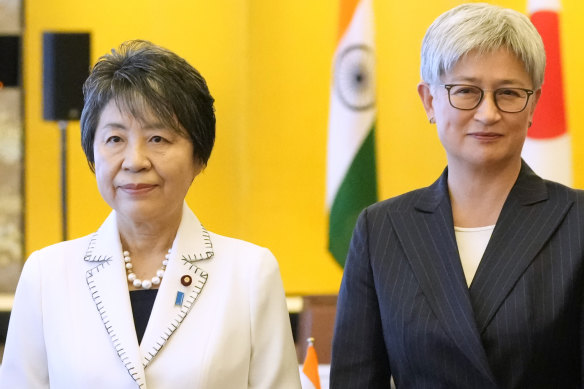
Japanese Foreign Minister Yoko Kamikawa (left) with Australian counterpart Penny Wong at the QUAD security talks in Tokyo in July. Credit: AP
“The LDP is far more conservative than the general population at large on various issues,” Nakano said.
“The ties to the Unification Church is also attached to their common belief in maintaining their traditional family values, rightful role of women in society, and therefore, for them to pick a female leader is going to be a real challenge that they would rather not do.”
Harris said Kamikawa had enjoyed a brief surge in popularity when appointed foreign minister, but this had dwindled and “she is middle of the pack when it comes to who the public wants to see as the next leader”.
Meanwhile, Takaichi, a heavy metal drummer in her youth and now a hardline conservative, has polled third behind Ishiba and Koizumi in several recent surveys.
What about the opposition?
The prospect of Opposition Leader Kenta Izumi, 50, who leads the Constitutional Democratic Party (CDP), capitalising on low LDP approval ratings and seizing a narrow path to victory at a general election has faded with Kishida’s departure. The general election must be held before the end of October next year.
“The CDP could have won the election with Kishida as the prime minister, but it gets much tougher against the new leader, who will likely be a very popular person. Even another landslide victory for the LDP is now a possibility,” Kato said.
Izumi was preparing for the likelihood he would face someone other than Kishida and was sharpening his attack lines to focus on LDP corruption and the need for wholesale political renewal when interviewed by this masthead in his parliamentary office in late July.

Students’ umbrellas at an elementary school in Hyogo Prefecture, Japan before being closed. Successive leaders have tried to reverse Japan’s falling birthrate.Credit: Bloomberg
“When the ruling party has corruption, the expectation of voters gets higher,” Izumi said. “In Japan, the economy isn’t growing. So what we need to see is something new.”
As a centre-left party, the CDP holds progressive policy position on social issues such as supporting legalising same-sex marriage and LGBT rights. Its economic policy centres on higher taxes on corporations and wealthy individuals, and expanding welfare support. Izumi favours curbing the growth in defence spending and reallocating it to education and childcare measures.
The CDP will hold its own its leadership election on September 23, with Izumi facing potential challenges from previous party leaders including former prime minister Yoshihiko Noda.
If Izumi stays on as opposition leader, he and the CDP will face the immediate challenge of pre-selecting enough candidates to contest the general election, particularly if it is called early by the new LDP leader.

Japan’s China challenge: A Chinese reconnaissance plane this week breached Japan’s airspace.Credit: AP
“At the moment we have 185 selected. However, in order to have single party leadership, we need at least 233 members. If the government actually gets dissolved, we won’t [have] enough time,” Izumi said.
He said he had canvassed support among other minor parties about forming a possible coalition.
But the CDP, which was formed in 2017, has also struggled to break free from the negative public perception attached to its earlier iteration as the Democratic Party of Japan (DPJ), which briefly wrestled power from the LDP and governed Japan from 2009 to 2012.
The party’s time at the helm was widely seen as chaotic, and it was heavily criticised by the Japanese public for its handling of the meltdown at the Fukushima nuclear plant following the 2011 earthquake and tsunami.
“The more the public is reminded of the DPJ years, the less likely it is that they’re going to trust the CDP with power,” Harris said.
Get a note directly from our foreign correspondents on what’s making headlines around the world. Sign up for the weekly What in the World newsletter here.